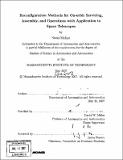| dc.contributor.advisor | David W. Miller. | en_US |
| dc.contributor.author | Mohan, Swati | en_US |
| dc.contributor.other | Massachusetts Institute of Technology. Dept. of Aeronautics and Astronautics. | en_US |
| dc.date.accessioned | 2007-12-07T16:10:37Z | |
| dc.date.available | 2007-12-07T16:10:37Z | |
| dc.date.copyright | 2007 | en_US |
| dc.date.issued | 2007 | en_US |
| dc.identifier.uri | http://hdl.handle.net/1721.1/39706 | |
| dc.description | Thesis (S.M.)--Massachusetts Institute of Technology, Dept. of Aeronautics and Astronautics, 2007. | en_US |
| dc.description | Includes bibliographical references (p. 115-118). | en_US |
| dc.description.abstract | Reconfiguration is an important characteristic in furthering on-orbit servicing, assembly, and operations. Previous work has focused on large assemblers manipulating small payloads, where the dynamics of the assembler is not significantly changed. This work seeks to identify the impact of reconfiguration on maneuver performance. Reconfiguration is considered in two categories: implementation and application. Implementation of reconfiguration consisted of developing a method for defining and updating a configuration, implementation on the SPHERES testbed, and execution of tests (in simulation and on the International Space Station) to assess the control performance improvement after reconfiguration. Four applications were considered in this work, two hardware applications and two systems applications modeled through simulation. The objective of the SWARM application was to demonstrate autonomous assembly capability through docking and undocking maneuvers. The objective of the SIFFT application was to demonstrate formation reconfiguration capability, through the expansion and rotation of an equilateral triangle of three satellites. The objective of the systems applications was to determine the impact of re-configuration in a larger mission context. | en_US |
| dc.description.abstract | (cont.) One application, Mass Property Update, considered how the choice of method for obtaining the mass property information impacts operations. The other application, Modularity Analysis, considered how the implementation of modularity is driven by the mission objectives. Overall, this work has served to demonstrate the control impact of reconfiguration though implementation on the SPHERES testbed. This implementation was used on two hardware applications to determine the performance of reconfiguration for assembly and formation reconfiguration missions. Also, the impact of reconfiguration has been studied in the broader systems context. The choice of method of mass property update was demonstrated to have an impact on operations, in terms of reliability and mass. Finally, the method incorporation of modularity for purposes of on-orbit servicing and assembly was demonstrated to be driven by mission design parameters. | en_US |
| dc.description.statementofresponsibility | by Swati Mohan. | en_US |
| dc.format.extent | 118 p. | en_US |
| dc.language.iso | eng | en_US |
| dc.publisher | Massachusetts Institute of Technology | en_US |
| dc.rights | M.I.T. theses are protected by copyright. They may be viewed from this source for any purpose, but reproduction or distribution in any format is prohibited without written permission. See provided URL for inquiries about permission. | en_US |
| dc.rights.uri | http://dspace.mit.edu/handle/1721.1/7582 | |
| dc.subject | Aeronautics and Astronautics. | en_US |
| dc.title | Reconfiguration methods for on-orbit servicing, assembly, and operations with application to space telescopes | en_US |
| dc.type | Thesis | en_US |
| dc.description.degree | S.M. | en_US |
| dc.contributor.department | Massachusetts Institute of Technology. Department of Aeronautics and Astronautics | |
| dc.identifier.oclc | 176872671 | en_US |
